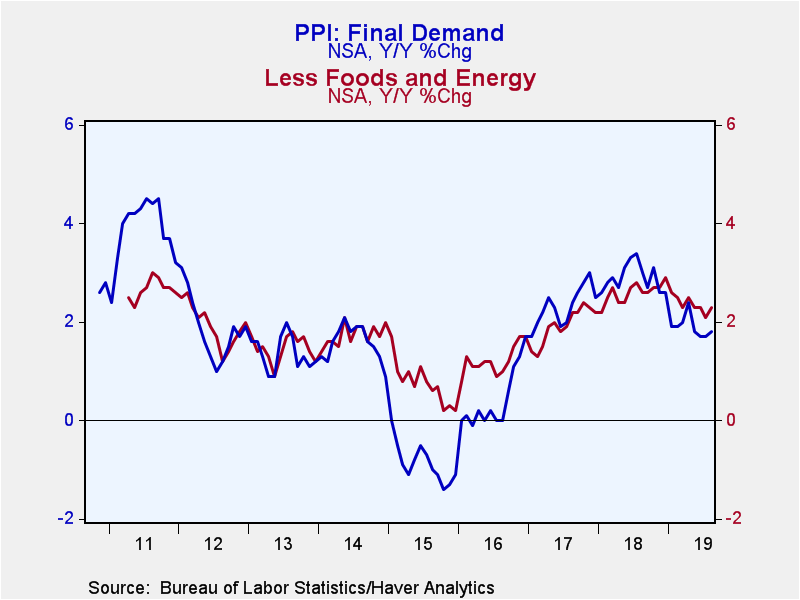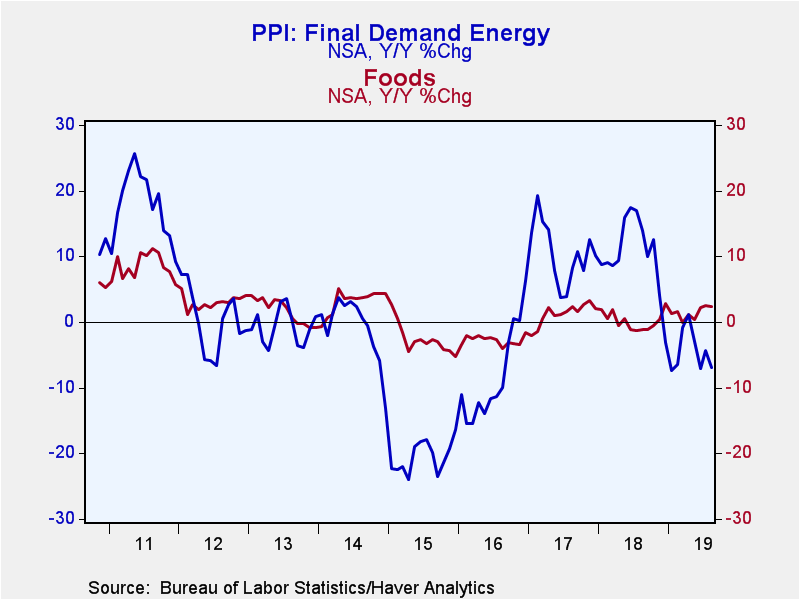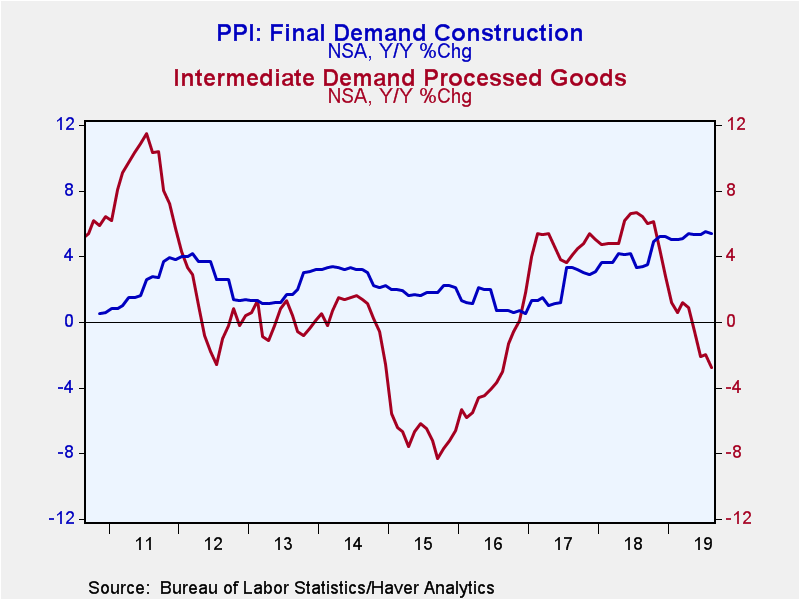 Global| Sep 11 2019
Global| Sep 11 2019U.S. Producer Prices Increase Minimally; Core Price Index Strengthens
by:Tom Moeller
|in:Economy in Brief
Summary
The Producer Price Index for final demand edged 0.1% higher during August (1.8% y/y) following a 0.2% July rise. A 0.1% gain had been expected in the Action Economics Forecast Survey. Producer prices excluding food & energy [...]
The Producer Price Index for final demand edged 0.1% higher during August (1.8% y/y) following a 0.2% July rise. A 0.1% gain had been expected in the Action Economics Forecast Survey. Producer prices excluding food & energy strengthened 0.3% last month (2.3% y/y) after edging 0.1% lower in July. A 0.2% rise had been expected. The PPI excluding food, beverages and trade services, another measure of underlying price inflation, increased 0.4% (1.9% y/y) last month after easing 0.1% in July. It was the largest increase in three months.
A 2.5% decline in energy prices (-6.9% y/y) in energy prices held back the increase in the PPI overall. It reversed the July increase. The decline reflected a 6.6% fall (-7.7% y/y) in gasoline prices which followed a 5.2% rise. Home heating oil prices fell 12.1% last month (-11.0% y/y) after rising 8.0% in July. The cost of electric power rose 0.3% (2.7% y/y) after strengthening 0.9%. Offsetting this increase was a 0.4% decline in natural gas prices, which were unchanged y/y.
Also working lower last month by 0.6% (+2.4% y/y) were food prices following a 0.2% gain. Beef & veal prices increased 1.0% (4.6% y/y) while fish prices declined 1.9% (+2.4% y/y). The cost of dairy products fell 0.7% (+5.8% y/) and fresh & dried vegetable costs were off 11.8% (NSA, +12.3% y/y). Fresh fruit & melon prices also weakened by 1.6% (-10.1% y/y). Egg prices surged by 21.6% m/m (NSA), but they were down by one-third y/y. Oilseed prices strengthened 5.6% (1.8% y/y).
Prices for core goods for final demand were unchanged in August (1.0% y/y) for the fourth time in the last five months. Core finished consumer goods prices rose a steady 0.1%, but the 2.1% y/y change was reduced from 3.2% last September. Core nondurable consumer goods costs also rose a steady 0.1% and the y/y change of 2.6% y/y was similarly weakened. Durable consumer goods prices improved 0.2% and an easier 1.2% y/y. Passenger car prices improved 0.1% (-0.3% y/y) but appliance prices weakened 1.4% (+9.2 % y/y). Private capital equipment costs increased 0.1% (1.9% y/y) after rising 0.2%. Government goods prices less food & energy also rose 0.1% (1.8% y/y) following a 0.2% improvement.
Services prices strengthened 0.3% (2.7% y/y) after easing 0.1%, while trade services prices rose a steady 0.2% (3.8% y/y). The cost of trade of finished goods rose 0.2% (3.6% y/y) for a second straight month. Passenger transportation fees jumped 1.4% (7.2% y/y), about as they did in July. A 0.2% decline (+1.8% y/y) in transportation & warehousing costs offset these increases. Services prices less trade, transportation & warehousing rebounded 0.5% (2.1% y/y) following a 0.3% drop.
Construction costs edged 0.1% higher (5.4% y/y) following a 0.6% jump. Private building costs gained 0.2% (5.3% y/y) but government building costs eased 0.1% (+5.2% y/y).
Prices for intermediate demand fell 0.7% (-2.9% y/y), down for the third month in the last four.
The PPI data can be found in Haver's USECON database. Further detail can be found in PPI and PPIR. The expectations figures are available in the AS1REPNA database.
| Producer Price Index (SA, %) | Aug | Jul | Jun | Aug Y/Y | 2018 | 2017 | 2016 |
|---|---|---|---|---|---|---|---|
| Final Demand | 0.1 | 0.2 | 0.1 | 1.8 | 2.9 | 2.3 | 0.4 |
| Excluding Food & Energy | 0.3 | -0.1 | 0.3 | 2.3 | 2.6 | 1.9 | 1.2 |
| Excluding Food, Energy & Trade Services | 0.4 | -0.1 | 0.0 | 1.9 | 2.8 | 2.1 | 1.2 |
| Goods | -0.5 | 0.4 | -0.4 | -0.1 | 3.4 | 3.3 | -1.4 |
| Foods | -0.6 | 0.2 | 0.6 | 2.4 | 0.2 | 1.2 | -2.8 |
| Energy | -2.5 | 2.3 | -3.1 | -6.9 | 10.2 | 10.4 | -8.4 |
| Goods Excluding Food & Energy | 0.0 | 0.1 | 0.0 | 1.0 | 2.5 | 2.2 | 0.7 |
| Services | 0.3 | -0.1 | 0.4 | 2.7 | 2.6 | 1.8 | 1.4 |
| Trade Services | 0.2 | 0.2 | 1.3 | 3.8 | 1.8 | 1.4 | 1.3 |
| Construction | 0.1 | 0.6 | 0.2 | 5.4 | 4.0 | 2.2 | 1.1 |
| Intermediate Demand - Processed Goods | -0.7 | 0.2 | -1.1 | -2.9 | 5.3 | 4.7 | -3.1 |
Tom Moeller
AuthorMore in Author Profile »Prior to joining Haver Analytics in 2000, Mr. Moeller worked as the Economist at Chancellor Capital Management from 1985 to 1999. There, he developed comprehensive economic forecasts and interpreted economic data for equity and fixed income portfolio managers. Also at Chancellor, Mr. Moeller worked as an equity analyst and was responsible for researching and rating companies in the economically sensitive automobile and housing industries for investment in Chancellor’s equity portfolio. Prior to joining Chancellor, Mr. Moeller was an Economist at Citibank from 1979 to 1984. He also analyzed pricing behavior in the metals industry for the Council on Wage and Price Stability in Washington, D.C. In 1999, Mr. Moeller received the award for most accurate forecast from the Forecasters' Club of New York. From 1990 to 1992 he was President of the New York Association for Business Economists. Mr. Moeller earned an M.B.A. in Finance from Fordham University, where he graduated in 1987. He holds a Bachelor of Arts in Economics from George Washington University.










